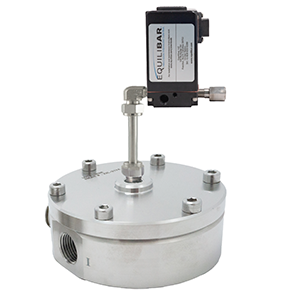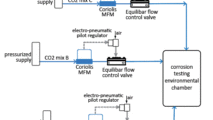Traditional flow control valves have difficulty in injection and metering applications where the downstream pressure is widely varying. Changes in required flow rate are compounded with changes in available differential pressure, creating a very wide range requirement for valve Flow Coefficient. It is difficult for a single flow control valve to be sized to handle such wide Cv range. The traditional solution has been to use two or three parallel control valves of different sizes to handle these widely varying conditions.
The Equilibar® flow control valve (FCV) operates in a fundamentally different way, and is largely unaffected by change in pressure downstream of the valve. The Equilibar FCV can normally function across flow rate variations of 100:1, regardless of wide changes in downstream pressure. This valve uses an air or nitrogen pilot signal and a sensitive diaphragm to control flow rate. Very small changes in the pilot pressure produce correspondingly small changes in the flow rate. Because the flow control valve is based on the design of a back pressure regulator, fluctuations or even wide variations in pressure downstream of the valve do not have a significant effect.

This flow control approach is not right for every application, and has three basic requirements:
- An active PID loop is required, with input from a flow meter, and output to a high resolution electro-pneumatic pressure regulator
- The upstream pressure should come from a relatively stable pressure source (such as regulator header or pump). This pressure can vary with increasing or decreasing flow rates, but should be free of rapid pressure fluctuations.
- A gas supply is required with a pressure slightly greater than the maximum supply pressure of the header or pump.
Well Injection Applications
Well injection applications involve the injection of a fluid into the bottom of the well to improve conditions of the well. These are a challenge for flow control valves because the downstream pressure of the wellhead can vary greatly with conditions and flow rate inside the well. In addition, the required injection flow rate can vary greatly as well.
By way of example, consider the following hypothetical application:
Maximum Supply Pressure = 300 psig
Range of injection pressure into wellhead: 0 psig to 270 psig
Range of Flow Required: 0.25 GPM to 5 GPM
Fluid density: water-like
The Maximum Flow Coefficient required for the injection is based on the maximum flow of 5 GPM, with an available differential pressure of only 30 psid( 300-270 psig). This result comes to Cv (max) = 0.91
The minimum Flow Coefficient is based on the minimum flow of 0.25 GPM and an available differential pressure of 300 psig. This result is Cv (min) = 0.014. This Max/Min ratio is 63 – well greater than the typical control valve range of 20:1.
Based on Back Pressure Valve Design
Equilibar flow control valve is based on the unique back pressure valves the company introduced in 2005. Over the years, Equilibar engineers and customers have discovered the significant benefits of these devices in demanding flow control applications where the supply pressure is largely stable.
Contact an Equilibar engineer to discuss your flow control application in more detail.
Learn how Equilibar back pressure valves work
Browse available back pressure regulator models.
View Wide Flow Control Range application and other Flow Control applications from Equilibar.
Learn more about our back pressure regulator technology and how it works.
Contact one of our Applications Engineers to help select the perfect back pressure regulator for your filtration application.








